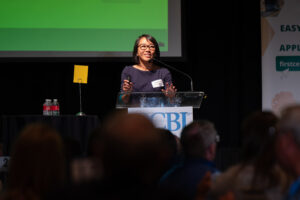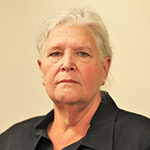Despite high interest rates and other challenges, the U.S. economy is not likely to experience a hard landing in the next year and half, Kanlaya Barr, director of corporate economics at John Deere, told business leaders at the QCBJ’s Mid-Year Economic Review.
“In the last 40 years there were eight cycles of these rate hikes and only two times it got us into a soft landing. The other six times, we ended up with a recession,” Ms. Barr told some 150 Quad Citians gathered at the Thursday, July 11, event at Bally’s Hotel & Casino in Rock Island.
Still, she added, “When you look at the probability right now, the market is thinking that we are more likely to end up with a soft landing scenario. In fact, the probability of going into recession in the next 24 months is actually at the lowest point compared to the last two years. So, it could be wrong, but right now the market is betting on the side of soft landing.”
That doesn’t mean there won’t be challenges ahead, said Ms. Barr, who joined the Moline-based John Deere a decade ago. Today, she manages a global team of economists that oversees all economic analysis including agriculture, construction fundamentals as well as short and long-range industry forecasts for John Deere.
“This time that we are in is an interesting time and I can look back as an economist and think about 10 years from now there’s going to be hundreds if not thousands of analyses that talk about the time we are in today,” she predicted.
“If you look at where the market has been and what the forecast has been on the interest rate over the past 18 years, the market has been consistently incorrect,” she added.
Market gets it wrong
Indeed, Ms. Barr said, “the only time that we saw that the market actually did correctly forecast that was right in the aftermath of COVID times.”
So what do we really know now, particularly when two different people can look at the same jobs report and say “great or horrible?” Ms. Barr said.
The economic outlook is different depending on your own circumstances, she said.
Looking at the macro-level, for example, “It doesn’t look so bad.” That’s particularly true for those who have money in the stock market or housing. “Those people are checking their 401(k) every day because it keeps hitting a new high,” she said.
Then there are homeowners who are locked into an interest rate below 4%. “You’re feeling pretty good,” Ms. Barr added. “But if you are on the other side of the economy where you are making it month by month, and your family decides to eat at a McDonald’s restaurant and as a family of four you pay $40 and you wonder how I can make ends meet?”
She added “People are looking at this situation and they see different things, so it’s plain outright confusing.” In an effort to clear up at least some confusion Ms. Barr shared her economic perspective for the next 12 to 18 months.
Here were her key takeaways as of Thursday:
- The interest rate will remain elevated. And “it is likely to be higher for longer and we might see that coming down a little bit this year but it’s likely not going to not to come down to where it was a few years ago.”
- Interest rates at the current level are subduing the market and are likely to fuel a slowdown next year, Ms. Barr said. At the same time, “we will see moderation in the farm economy.”
- The housing market will remain subdued impacting a large sector of the country.
Inflation rate down
It’s difficult to gauge with any certainty where inflation rates are going in the next five years, she said, and there is confusion over what should be done about them. Last week, for example, U.S. inflation fell in June for the third straight month. It stood at 3% still above the Federal Reserve’s 2% goal.
And while the inflation rate is coming down, Ms. Barr added, it isn’t coming down as fast as it needs to to help bring down interest rates and boost the economy.
Why? The modern U.S. real economy is less interest-rate sensitive than it once was, Ms. Barr said, because it has shifted from a manufacturing-driven economy to a service-driven one in the last two decades. Manufacturing is heavily impacted by “the cost of everything,” she said.
That’s not true of service businesses such as the financial sector which is introducing more financial instruments to the market that help investors hedge their risks.
The nation’s manufacturing sector is not shielded by that shift. Neither is what Ms. Barr calls a “moderating” farm economy which impacts her employer, the ag community, and the entire Midwest economy.
Farm economy challenged
She stressed that the ag economy is no different than other markets such as lumber, trucking and automotive. “It is cyclical,” she said, and farmers have gone through this cycle before.
In 2012-13, for example, “we saw higher corn prices because of demand for biofuels and we topped that off with a really dry year in 2012,” she said. So prices went up very high.
Fast forward to today and Ms. Barr said, “In the past 12 months, the balance sheet locally has changed quite a bit. We kind of have more crops than what we expected” despite persistent drought, so supplies have been growing and prices have been coming down. For example, corn dropped 3% from a year ago, soybeans are down 20% and wheat dropped 25%.
“The new crops on the ground prices also are likely to decline for this year’s crop as well, ” she said. “That’s going to hit the balance sheet for our producers.”
“If the trend yields hold, if we have normal weather, which right now a lot of signs are pointing to, we’re going to have a record year on corn and soybean yield in the U.S.,” she said. “So that’s going to mean we’re going to have more crops and therefore lower prices and that’s what the general market is trending on right now.”
With the price of crops going down 25% year over year, she said, farmers’ margins are likely to go lower again in 2024. Those farmers are further challenged by lingering higher interest rates that impact their operations and their ability to make capital project investments.
Farmers feels pinch
That in turn, impacts manufacturers including Deere which already has made significant workforce cuts at its plants in the Quad Cities, Waterloo and elsewhere to compensate for a slow-down in demand for its equipment.
Inflation remains a challenge, too, for Deere and other manufacturers. But there is some moderately good news there. “Inflation is not not where we want it to be but there are signs that it’s coming down – even though slowly – but it’s coming down,” Ms, Barr said.,
“Look at the labor market,” she added. “In the peak of COVID, if you’re looking for a job there were two jobs for every job seeker looking for a job. Today, that number is 1.2 so it dropped drastically.” With jobs coming down as a result of that, she said, the nation will see unemployment rates creeping up to about 4.1%, which is still relatively low.
Analysts also are watching to see if wage growth will decline as well. In addition, she said, the policies the Fed is putting in place right now should start to work over the next 12-18 months.
Likely to keep inflation high is continued widespread home buying challenges that include too many people chasing too few properties as well as rising interest rates.
Ms. Barr warned that businesses also are going to be dealing with high interest rates for the next 12 to 18 months. That’s going to lead to an economic slowdown in 2025 because of the high interest rates and the housing shortage.
“Statistics show 17% of homeowners in the U.S. actually have a mortgage rate below 4%. So until you see the mortgage rate coming down from … that market is frozen up.” So the supply is tight, she said, but what about demand?

Millennials hit hard
“We’ve got to feel for these millennials. When they graduated from school in 2009 what did they get hit with? The Great Financial Crisis. It put them back. They can’t find jobs. It set them back for years,” Ms. Barr said.
“By the time these people were able to afford a home, guess what? Now they can’t because the home value now went up from $380,000 median home price to $440,000 or $420,000,” she added. That means it will take some time for them to actually be able to afford these homes.
Labor issues continue to impact nearly all employment sectors though they have improved since the Great Resignation in 2021.
Employers, for example, shifted their focus to work harder to retain good employees. She pointed to the rapidly drooping price of two-by-fours at your home improvement store. “Those lumber guys are not laying off their people because they’re afraid if they lay them off they can’t get them back.”
Ms. Barr said part of what drives the numbers are conflicting policies. While The Fed is trying to slow down the economy by increasing the interest rate, the U.S. government is creating new industrial programs that drive it back up in order to bring strategic sectors spark business in the U.S. and bring other strategic sectors back to the country, For example, clean energy tax credits that have fueled an investment of $150 billion in clean energy production and manufacturing, and another $88 billion in electric vehicle and battery production.
While the investments are welcome, “those incentives are continually working against what the Fed is trying to do to slow down the economy.”
QC leaders share their views
The QCBJ’s Midyear Economic Review also featured a panel discussion with top Quad Cities business leaders. It was moderated by Steve Sorensen, owner and managing director of Strategy in Progress. The panel members and a few of their comments include:
- Dennis Campbell, farmer and entrepreneur from Crystal Creek Enterprises, whose farm in Dewitt, Iowa, dates back to 1854 and grows seed corn. “Down on the farm it may be a little bit difficult for the next couple of years so we recognize that,” Mr. Campbell said. In 2023, “people struggled with dry conditions” and in 2024, he said, “they were the 180 degree opposite of the spectrum. Mother nature can be so cruel sometimes.”
- Ian Fink is the owner of Crawford Companies, a unique and diversified company based in Rock Island. “Were a contractor. We’re in commercial and industrial spaces. We’re a fabricator and we’re in manufacturing as well so we have to look at things with a lot of different space,” he said. He said his company has “been in growth mode since 2023.” This year, he added, “has been really solid for us.” He credited the Crawford team for revenue outpacing overhead and direct costs, as well as more than 40% growth since last year.
- Jim Nelson, president & CEO of Parr Instrument Company, whose company recently broke ground on a major expansion at its current Moline location. That 125-year-old company manufactures research equipment. Though it is a small company, it’s a global brand that recorded some $40 million in revenue last year. Looking ahead, he said, as the industry Parr services, it will focus on the new things happening including sustainable material, battery research and carbon capturing. There is, he said, “a lot of startup companies and a lot of government stimulus chasing in that industry so that has been beneficial to us.” So much so that Parr set an all-time record year in 2022 and 2023, but it expects that to back off some in 2024, he said.
- Kent Pilcher is president & CEO of Estes Construction in Davenport. “Things in the construction world really were crazy just slightly post-COVID,” Mr. Pilcher said. That included high inflation and material costs and supply chain disruptions. “So when you plan a 12-month project, it would take 14 or 15 maybe longer because you couldn’t get key pieces,” he said. Then there were the labor issues, all of which began to normalize as talent and material became more available. The current economic conditions, however, are creating new challenges. “We’re in a capital spending business. Usually that’s the first expense that a company slows down. They get conservative when they are uncertain about the economy,” Mr. Pilcher said. As a result, Estes is planning more projects but is executing fewer of them.
- Aaron Tennant is president & CEO of Cantrell’s Towing & Recovery, founder of Total Solutions Inc., a business service company, and a number of entertainment venues. Mr. Tennant, who has a long background in trucking said, “It’s probably one of the worst times I’ve seen.” That’s because economic conditions brought more people to the trucking market that “that probably shouldn’t have been there.” That resulted in a glub of capacity. Faring far better, is Cantrell’s container line operations in Savanna, Georgia, and South Carolina. “They’re seeing an export volume decline but the import volume is actually increasing,” he added. Regarding Mr. Tennant’s entertainment and hospitality venues including The Rust Belt, he said, “We’re certainly seeing a decline in discretionary spending which could be a little challenging right now.” They are tightening the belts. For example, he said, visitors will “come to a $20 show, but they won’t come to that $70 show.”











